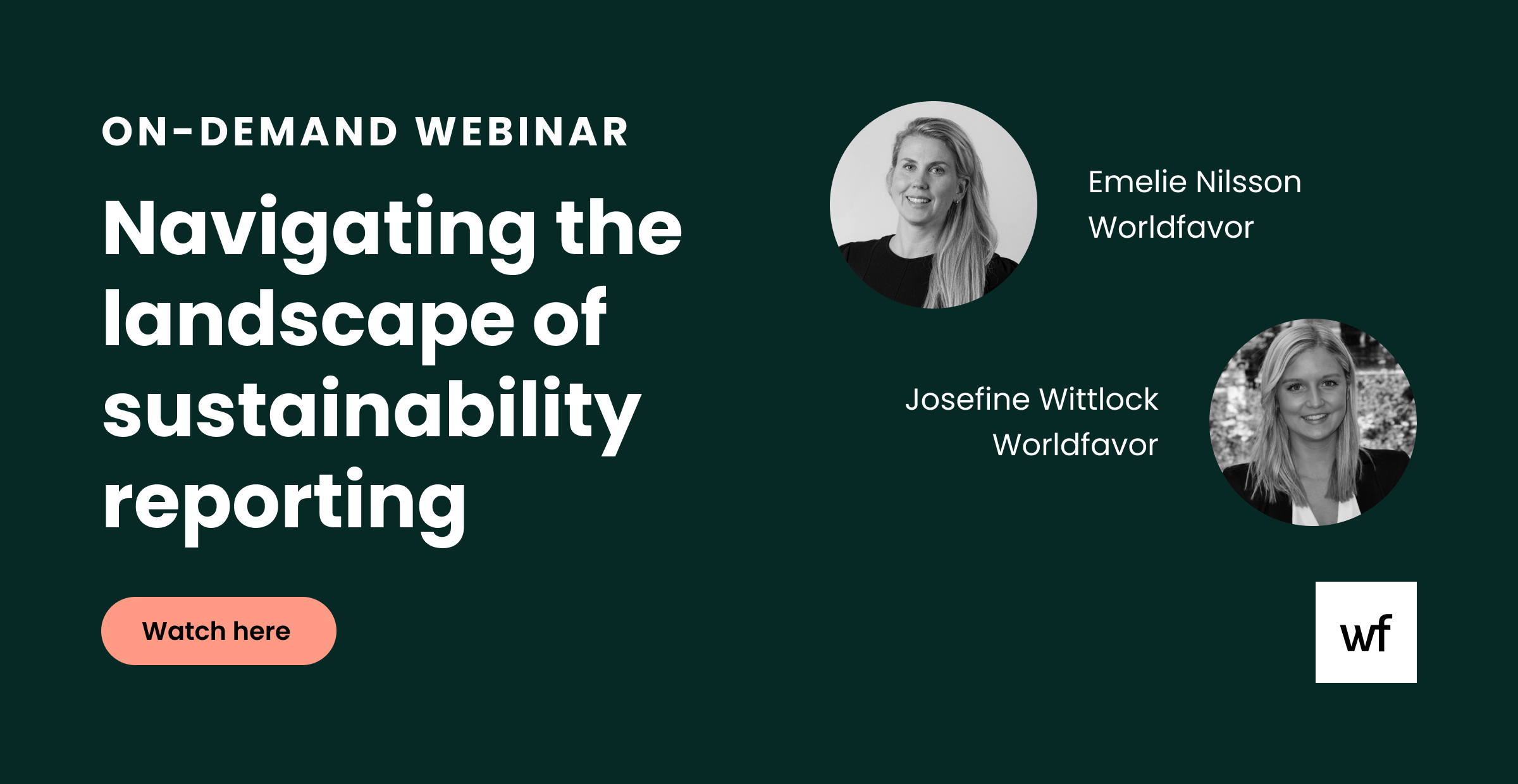FAQ: 5 common challenges in sustainability reporting

Today, less than 5% are satisfied with their current sustainability reporting process. As the reporting landscape is rapidly shifting through new policies and regulations, such as the EU Green Deal and the EU Taxonomy, enabling a smooth and stress-free reporting process should be every business's top priority. But what can businesses do to tackle their main reporting frictions and make their sustainability reporting process run smoother?
In our recent webinar Navigating the landscape of sustainability reporting, experts from Worldfavor, together with the panelist, discussed the challenges of sustainability reporting and shared their best practices for boosting your reporting game. In this blog, we have gathered some of the audience’s key questions – both the ones that were addressed by the panel and those that didn’t make the cut – along with our answers!
Missed the webinar? Don’t worry! We got you sorted, you can watch it HERE!
1. What would be your recommendations for companies just starting now with sustainability reporting?
If you are at the beginning of your sustainability journey, developing a strategy can feel overwhelming. Remember, starting small is better than doing nothing at all – and building a strong sustainability strategy takes time! Luckily, there are several established and internationally accepted frameworks to align with, such as the GRI, SDGs, and ISO. Not only do they enable clarity on how to develop, manage and measure the business’ wider impact, but also assure that your strategy will be aligned with international standards and goals.
One common misstep when getting started is to rely completely on spreadsheets, such as excel, to aggregate the data. While spreadsheets are brilliant when they work, the more data that needs to get stored and with multiple users needing access to them – the trickier it gets. Rather, take advantage of the dedicated sustainability reporting software out there!
With sustainability reporting software, you will:
- Eliminate the risk of the system collapsing just before the deadline
- Enable the opportunity to work simultaneously within your organization
- Replace overwhelming documents with visualized dashboards
… Just to name a few of the benefits!
We know that starting with sustainability reporting can be a challenge. That is why our sustainability management software provides all its new users with ready-to-use KPIs aligned with the most recognized frameworks and international guidelines to ease the process of starting.
2. Do you recommend reporting data more frequently or just once a year?
It might be tempting to monitor data annually because after all – we’re used to having one reporting season. However, as the entire panel of the webinar agreed upon – the limitations of annual sustainability reporting outweigh its benefits.
Working with data that has been put in store for months before being addressed tends to become more reactive than proactive – and may result in not achieving your set-out goals. Reporting once a year hinders companies from being able to spot vulnerabilities and take immediate action.
Benefits of monitoring data frequently:
Collecting data on a more frequent basis and working with it in real-time is enormously valuable in things like sustainability management as it provides the opportunity to take action and react quickly, and generally engages employees to be more proactive and take initiative in the process. More frequent reporting also empowers suppliers and other data providers to follow their own progress, too. So it’s a win-win!
3. How do you deal with rapidly changing reporting standards?
In 2018, the IPPC warned in their Global Warming of 1.5°C report that we can’t stay within the 1.5°C limits without the private sector onboard. Ever since, the number of sustainability standards and frameworks – both voluntary and mandatory – has exploded. The various frameworks are designed to create value across and within different industries, organizations, and financial performances. However, with diversity comes the confusion – what applies to whom and when? If you feel lost, you are not the only one. At the risk of sounding cliché, the key to always be up-to-date on what applies to your organization is knowledge. There’s no easy way around it but to gain the knowledge through the use of consultants, dedicated sustainability platforms, or your own internal resources. In addition, subscribing to our weekly blog is a great start to always stay on top of the latest in the sustainability reporting landscape! We cover all the important reporting changes, dates to write down, and tips on how to boost your reporting process!
4. What's the most important part to start reporting on; environmental, social, or governance?
According to the Global Reporting Initiative (GRI), sustainability reports are an overview of an organization’s environmental, social, and governance impacts caused by its activities. Thus, disclosing all these matters is equally important and the ultimate goal in the long run. However, if you’re just starting with your reporting process and don’t have the resources to focus on all parts simultaneously, then prioritize sustainability challenges linked to your business impact – where can your organization make the biggest change? Start small, think big!
5. How can you improve the quality of data?
The quality of one’s sustainability reporting is entirely dependent on the quality of the data being used. If the data is inaccurate or incomplete, you could jeopardize the entire nature of your assessment. Validating the data is not an easy task, and our report found that 46% find poor data quality as challenging in the reporting process. Full traceability of who reported the data, when it was reported, and for what period is key for data validation.
In addition, having a digitalized system can save a huge amount of time for suppliers, while enabling you to easily analyze and manage the information. Being able to use a tool that gathers, analyzes, and compares your internal data for you provides an opportunity to minimize your administrative burden – so you can focus wholeheartedly on your sustainability journey.
Related blogs you might like:






%20as%20the%20deadline%20approaches.%20Learn%20about%20compliance%20requirements%2c%20potential%20delays%2c%20and%20key%20updates..png)

